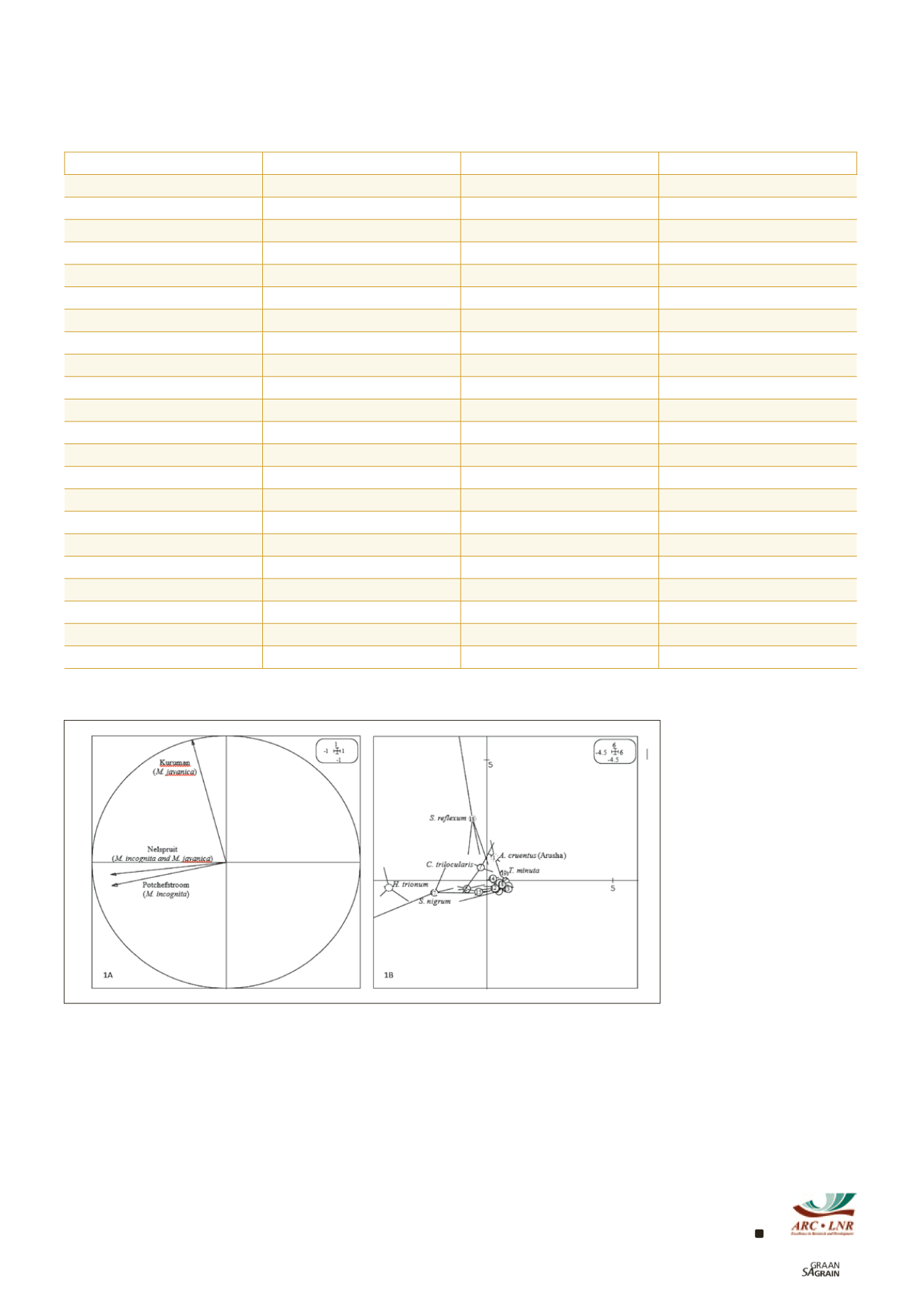

93
August 2018
M. javanica
or mixed populations. Several of the weed species
screened were excellent and/or good hosts of either
M. incognita
,
M. javanica
and/or mixed populations of the two species.
Although
T. minuta
is generally being referred to as a non- or
poor host for a variety of nematode pests, results from this study
showed that it has the potential to serve as a good host for mono-
culture
M. javanica
populations as well as mixed populations of
M. incog-nita
and
M. javanica
.
Future prospects
Notwithstanding this study on weeds, variable host efficiency of
root-knot nematodes has been demonstrated for a range of crops
by other authors. A probable explanation for this is the exposure
of weeds to different populations of
M. javanica
and
M. incognita
and/or mixed root-knot nematode species (
M. incognit
a and
M. javanica
) as a result of our study.
The occurrence of mixed root-knot nematode species populations
in particular is experienced in South African agricultural soils,
where
M. incognita
and
M. javanica
often occur together.
The phenomenon of variable host suitability needs to be studied ex-
tensively by screening the weed species to different
populations of
Meloidogyne
species, since such an
approach will provide more insight in this regard.
WEED SPECIES
KURUMAN
NELSPRUIT
POTCHEFSTROOM
Amaranthus cruentus (Arusha)
11,4 (41 125) ef
7,6 (832) bcde
8 (1 336) ab
Amaranthus hybridus
7,5 (461) abc
8,1 (605) bcdef
8,8 (931) ab
Amaranthus tricolor
9,8 (659) cdef
8,1 (1 260) bcdef
8,8 (3 043) ab
Bidens bipinnata
5,6 (134) a
5,8 (10 925) abc
7,2 (203 ab
Chenopodium carinatum
8,2 (2 276) abcd
8,3 (2 981) bcdefg
8 (638) ab
Cleome gynandra
8,9 (1 800) abc
8 (823) bcdef
7,5 (348) ab
Corchorus trilocularis
10,5 (10 704) def
9,7 (48 431) efgh
7,9 (391) ab
Crotalaria sphaerocarpa
7 (263) abc
10,5 (4 2685) efgh
8,3 (356) ab
Cynodon dactylon
8,3 (668) abcd
6,2 (116) abcd
8,5 (519) ab
Cyperus rotundus
9 (3 475) bcde
5,8 (121) abc
7,6 (1 318) ab
Datura ferox
7,6 (792) abcd
5,9 (79) abc
7 (489) ab
Datura stramonium
7,1 (1 194) abc
6,1 (97) abcd
7,9 (338) ab
Eleusine corocana
9,9 (66 810) cdef
5,3 (155) ab
7,7(297) ab
Hibiscus trionum
1
12,5 (34 649) a
12,3 (32 882) h
12,4 (27 344) c
Ipomoea purpurea
8,7 (1 091) bcde
11 (21 322) fgh
9,3 (1 628) bc
Sorghum bicolor
6,6 (228) ab
3,1 (214) a
7,7 (18 043) ab
Solanum nigrum
8,8 (4 568) abcde
11,5 (32 854) gh
9,5 (70 763) bc
Solanum retroflexum
12,5 (171 746) a
9,2 (274) defgh
9,3 (11 177) bc
Tagetes minuta
2
8 (2 390) abcd
8,6 (1 821) cdefg
5,6 (50) a
Urochloa panicoides
7,3 (58) abc
9,2 (47) defgh
6,6 (215) ab
P value
0,0000
0,0000
0,0000
F ratio
9,255
14,37
4,268
1
Good-host standard;
2
Poor-host standard;
3
Ln(x+1) transformed data with real means in parenthesis
Figure 1: Principal Component
Analysis (PCA) indicating (A)
the relative position of the dif-
ferent
Meloidogyne
species with
regards to the host reaction of
20 weed species that were evalu-
ated against, at three on-farm field
sites and (B) the difference in
susceptibility levels of the weed
species to these root-knot nema-
tode species.
Table 1: Root-knot nematode eggs and second-stage juvenile (J2) population levels 50 g/roots of 20 weed species
grown in field, three sites.
















